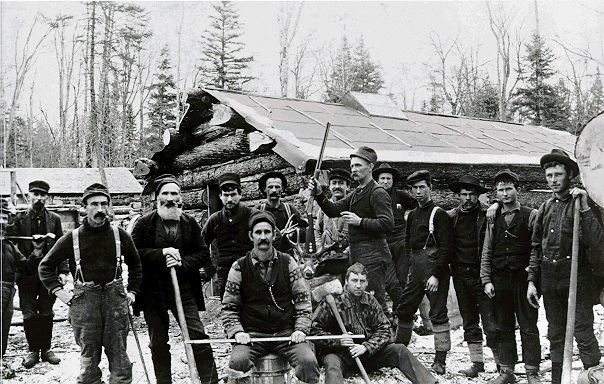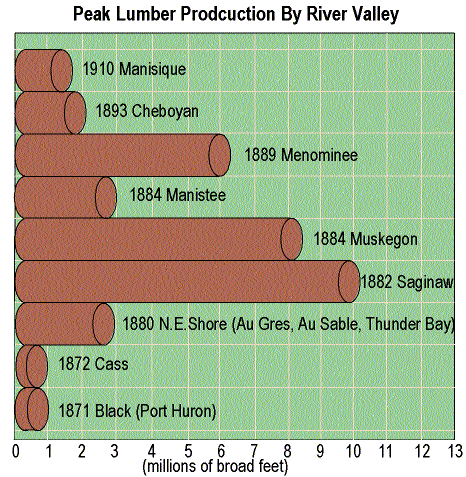From 1860 until 1910, the harvest and sawing of logs and the marketing of lumber was the major non-agricultural industry of the state. Immense fortunes were made. One of the major reasons for the later concentration of the automobile industry in Michigan was the fact that Detroit had men whose large fortunes had been made in lumbering and mining and who were willing to invest money in automobile plants. There was a mixture of pine and politics which deserves more attention from historians than it so far has had. The movement of population into Michigan in the half-century during which lumbering was dominant brought in a number of new elements. Among the workmen, Canadians, Irish, and Scandinavians, especially Swedes, were heavily represented. But the proportion of foreign-born was not nearly so great in the lumber camps as in the mining regions. Natives outnumbered foreign-born in 1890 in two important lumbering counties, Muskegon and Manistee, by almost two to one.
The loggers themselves
Lumbering employed many Michigan residents. It made the fortunes of a few men such as
Charles Hackley of Muskegon, Louis Sand of Manistee, and Perry Hannah of Traverse City.
These men were exceptions to the rule, however. The vast majority of men employed in the
lumber industry worked long hours for low pay. Lumberjacks, most often single men in their
20's, spent the winter in the woods, working from dawn to dusk six day a week, cutting,
hauling, and piling logs.
Between 1840 and 1870, Michigan loggers came primarily from New York,
Ohio, New England, and Pennsylvania. Throughout this period, however, the proportion of
Michigan-born among the population was steadily increasing. Canadians always constituted
the largest single group of foreign-born lumberjacks.
The "shanty boys" (as lumberjacks were called) used axes and saws
to fell the giant white pine trees. The handle on the one-man crosscut saw allowed a man
to cut down a tree alone. Two men used a two-man crosscut saw that had a handle on each
end.
Once a tree was felled, the shanty boy used a cant hook, a pole with a
hook attached to its end, to roll and handle the log. They dragged the logs to the river
bank with log chains--often with swamp hooks attached--to await the spring thaw. At the
banking ground the mark of the lumber company that owned the logs would be pounded into
each log's end with a log marking hammer.
During the final quarter of the 19th century, many counties grew rapidly as loggers’
axes and saws felled the area’s bountiful pines and hardwoods. Missaukee County
(home to the city of Cadillac) was one such place. By the early 1880s, eight
sawmills, which employed approximately one sixth of Missaukee County’s entire
population, dominated its economy. During the 1870s, Missaukee County logging camps cut
approximately one hundred million board feet of lumber annually. However, most of the
county’s logs were floated to mills in Muskegon and Manistee. After being cut, the
logs were hauled to streams and rivers where they were stacked. In the spring, dams that
had collected melting ice and snow were opened. The headwaters of the Muskegon and a
branch of the Manistee then carried the logs westward.

Source: Unknown
A typical lumber camp included a bunkhouse, cook shanty and other buildings necessary for
the work of the men, horses and oxen. This photograph shows loggers posed in front of a
Clare County logging camp that has buildings constructed of logs. The man seated in the
center of the photo holds a log scale. The seated man next to him holds a double-bitted
axe. Behind them, a camp member raises his rifle to celebrate the deer that will provide
venison for dinner (along with the ever-present beans). Other men hold long-handled
tools--the photographer did not include the end of each pole with the tool that determines
whether it is a cant hook, a peavey or a pike pole.
Logging and sawmill activities declined rapidly, however, as the
remnants of the forests, which had looked endless, were cut or burned. The hundreds of
large sawmills, which had produced volumes of lumber never seen before nor since, ground
to a halt, and many of the sawmill towns and their inhabitants passed into history. Below
is an image of just one of these sawmills.
During the second half of the 19th century Michigan was the
nation’s leading lumber producer. Michigan lumber was used to build and rebuild
Chicago, Milwaukee and other midwestern cities, as well as the many farms on the treeless
midwestern prairies. Many of Michigan’s cities---Saginaw, Bay City, Alpena,
Cheboygan, Traverse City, Manistee, Ludington, Muskegon and Grand Haven, began as sites
for lumber mills. Located on Lake Michigan, Muskegon was the state’s leading single
producer of lumber. (As a region Saginaw and Bay City together produced more than
Muskegon.)

Source:
Michigan State University, Department of Geography

Source: Unknown
A RAFT OF LOGS, TIED TOGETHER, DESTINED FOR TRANSPORT TO THE OTHER SIDE OF THE GREAT LAKES
Many men made huge fortunes from the logging industry. These men are often called lumber
barons, and Michigan had many. There also many other results of logging, including the
growth of cities around the mills, the quick spread of farming (the land was easier to
clear) and the change in Michigan’s environment after the trees were gone.
Of the many lumbermen who became wealthy, some took their wealth and
left the state when lumbering ended. Those who did not leave created a social and economic
infrastructure--banks, railroads, newspapers and churches--that was easily adapted to
subsequent industries. Some Muskegon lumbermen, however, went beyond this infrastructure
and used their skills to attract new industries to replace the lumber mills. Charles
Hackley, one of the more famous "lumber barons" was from Muskegon.
Charles H. Hackley arrived in Michigan in 1856 with seven dollars in his pocket. He made
his fortune in lumber. His estate was reported to be worth more than $12 million at his
death in 1905. During his lifetime and through his will he donated more than $6 million to
the city of Muskegon, giving it to a hospital, an art museum, a library, a park and
schools and churches. Hackley used much of his acquired wealth to improve the lives of
people living in the Muskegon area, and hence even today many buildings, streets, and
other landmarks in the Muskegon area are named for him.
In an interview, Charles Hackley said that: “a rich man to a great extent owes his
fortune to the public. He makes money largely through the labor of his
employees.....Moreover, I believe that it should be expended during the lifetime of the
donor, so that he can see that his benefactions do not miscarry and are according to his
intent....To a certain extent, I agree with Mr. Carnegie ....that it is a crime to die
rich.”
The list of the Hackley donations is a long one, but truly
remarkable. Some of these would include:
• Hackley Public Library - Site, Building and Contents
• Hackley Public Library Endowment
• Hackley Art Gallery - Site, Building and Contents
• Hackley Art Gallery Picture Fund
• Hackley Park
• Hackley Manual Training School and Gymnasium - Site, Building and Contents
• Hackley Athletic Field
• Hackley Hospital - Site, Buildings and Contents
• Hackley Hospital Endowment
• Soldiers’ Monument in Hackley Park
• Statues in Hackley Park
• City of Muskegon Poor Fund Endowment
• Julia E. Hackley Educational Fund Endowment
• Muskegon Humane Union Endowment
The total of all of these gifts had a value of about $6,000,000, an enormous sum even
today.
When the timber of the original forests was gone, it was essentially all gone, having
been cut, or burned in uncontrollable holocausts. The people, industries, and businesses,
all of which had peaked with the big logging boom, declined abruptly after the discovery
was made that the forests were not inexhaustible. Today, one can find a few white
pine stumps in Michigan's forests--reminders of the glory days and glorious forests of
yesterday. In some places in Michigan, entire landscapes
are dominated by such stumps
Source: Photograph by Randy Schaetzl, Professor of Geography - Michigan
State University
The first area where many mills were built was Saginaw. Six rivers converge to form the
Saginaw River which empties into Saginaw Bay and then Lake Huron. The rivers are the
Chippewa, Tittabawassee, Cass, Bad, Shiawassee and Flint. Rivers played a very important
part for the loggers because the lumber had to be floated to the mills and then to market.
The primary effect of the lumber industry upon the State of Michigan
was economic. The timber boom in the latter half of the 19th century brought millions of
dollars into the state, both to lumbermen and those who supplied them. Thousands of men
found employment in some aspect of the business. The decline of lumbering also had its
effects; both individuals and entire villages and cities, formerly thriving, lost their
most important source of income.
The lumbering era also saw vast changes in the natural environment of
northern Michigan. The conservation programs in effect today on
state lands grew out of concern over the conditions the loggers had left behind them.
Some of the images and text on this page were taken from various issues of Michigan History magazine.
This material has been compiled for educational use only, and may not be reproduced without permission. One copy may be printed for personal use. Please contact Randall Schaetzl (soils@msu.edu) for more information or permissions.